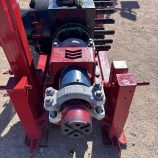Well Completions Technology: Product Advancements

Posted: November 29, 2023
Well completions begin the moment a drill bit first taps into a productive reservoir. The process is incredibly costly, so operators need to achieve maximum output during the life of the well to produce the lowest cost per barrel. Advancements in well completion equipment have led to the development of highly complex reservoirs in remote locations, with higher deviations, greater depths, and longer laterals.
The implementation of new completion technology is an important step towards achieving higher production at lower costs. One area of focus should be the essential flow control products that manage completion control system flow pressure. Improved component designs feature more robust material composition and strategic technical integrations that improve operation safety as well as offer system integration flexibility while delivering high-rate production for the entire life of the well.
With 60 years of innovation behind us, Gilmore continues to be an industry partner in the evolution to greener, faster, safer, and more cost-effective operations. Let’s look at recent advancements impacting well completions. We’ll also highlight simple operational strategies to boost profitability.

Revolutionizing Well Completions: A Look at Recent Tech Advancements
The success of a well’s production and depletion relies heavily on successful completion and workover operations. High upfront capital investment, long lead times, and low oil prices have compelled companies to explore creative solutions to maintain efficiency, ensure safety, and reduce costs.
For instance, innovations in riserless light well intervention systems improved efficiency and safety by lowering the required staff for offshore interventions onboard.
Operators are focusing more intently on their well planning strategies. Their selection of high-quality, durable, and performance-enhancing components helps optimize efficiency in deep depleted reservoirs and complex drilling conditions. Retrofitting autonomous inflow control devices (AICDs) has also been a successful method in increasing reservoir sweep and productivity. The self-adjusting devices choke back high-water producing areas, while enabling other oil-saturated areas to produce more from the well.
Service providers are resourcing debris-tolerant flow control valves as a replacement in landing strings for subsea applications to combat dirty control fluid and solids buildup in existing systems. Unconventional service providers are turning to large-bore completion systems for increased flow and minimal connection points to reduce leak paths. Let’s take a closer look.
Large-Bore Completion Advances
Advances in wellbore equipment has enabled simplified well completions to yield greater value. One such innovation is the use of large-bore manifolds. The larger production tubing increases the flow area and reduces flow restrictions.
While larger monobores have been used for some time, the system technology has continued to advance, yielding the following benefits:
- Reduced gas turbulence areas
- Lower long-term operational costs through accelerated reservoir depletion and a reduced number of wellbores
- Possible elimination of one or more platforms
- Earlier return on investment (ROI)
- Lower maintenance costs
Traditional fracking requires hundreds of components to handle extreme pressures, resulting in a lengthy assembly and a connection process that potentially creates multiple leak paths, requiring continuous monitoring.
With significantly fewer components, newer large bore systems improve operational efficiency. A single large-bore inlet has fewer connections and replaces multiple tie-in lines on conventional fracking trees. So, there are fewer leak paths to monitor. The simpler system also reduces the iron required for operations equipment.
Large-bore completion systems have been used in monobore, extended-reach, and deepwater wells, ranging from cemented-liner, open-hole, and sand-control applications. The advantages can improve overall project economics by millions of dollars.
Landing String Advances
Landing strings are safety systems that connect to the wellhead on the seabed, enabling interventions from a floating vessel in a secure manner. The use of hydraulically controlled valves within the system provides enhanced well control and cutting and sealing abilities. This allows swift shut-in of the well and disconnection of the vessel in emergency scenarios, such as during adverse weather or a drive off.
As technologies advance, operators are pumping higher volumes at higher rates and higher stage counts to improve production and operational efficiency. This, however, can also erode components to the point of failure—potentially resulting in decreased production, expensive remedial solutions, or both.
As a long-time leader in flow control solutions, Gilmore provides products that enable operators to leverage these advancements without risking high-cost repairs and downtime. By prioritizing reliability and durability, our components meet the demands of the harshest operating conditions.
Advanced Flow Control: Gilmore’s Strategy
Gilmore’s progressive valve technologies offer versatility, durability, and reliability for a variety of control systems in multiple markets, enabling operators to improve efficiency, safety, and cost savings. To achieve this, our product strategy entails:
- Modular and Adaptable Design. Operators can then use Gilmore products in existing system designs or new system designs.
- Component Endurance. Product service life increases uptime, efficiency, and productivity and reduces the overall cost of ownership.
- Debris-Tolerant. Products operate in dirty control fluid–reducing maintenance intervals.
- Corrosion Resistant. High-performance materials meet NACE MRO175 compliance and low H2S absorption.
- Strategic Spares. Gilmore offers spare kits, training, and an aftermarket maintenance and repair service. This resolves problems quickly and ensures that components are rebuilt to the latest design revision with a new factory warranty.
Unlocking Efficiency and Performance: Gilmore’s Cutting-Edge Products for Well Completions
While we offer a complete line of flow control solutions for interventions, completions, and plug and abandonment systems, Gilmore also tailors components to meet client specifications. This includes demands of existing system applications, prototyping, and new system development. Our control valve designs employ soft-sealing and shear-sealing technologies utilizing specialty materials and tungsten carbide to achieve industry-leading reliability and durability.
Our line of GEN2 flow control valves is subject to thorough qualification testing to exceed global standards for cycle life performance. Gilmore’s product engineers support material selection and design decisions through field and lab performance data; this helps ensure reliable flow control solutions with minimum maintenance requirements and downtime.
To support landing string reliability and durability, Gilmore offers three critical flow control components with exceptional performance:
Mark IV Shuttle Valve
Leveraging the latest technology, our Mark IV shuttle valves are suitable for both new build equipment and system upgrades where you want the most reliable and serviceable shuttle valve in the market.
Mark IV shuttle valves are capable of advanced pressure management where redundant hydraulic pressure supplies are required. All shuttles are hydraulically damped and can be readily reconfigured and redressed inline. They also have improved seat geometry to eliminate shuttle metal-to-metal coining. This enables improved stability, better regulation, and remarkable durability.
Selector Cartridge Valve
Control fluid contamination and solids-buildup are common issues that significantly reduce system performance. Whether in offshore platforms, distributed control systems, hydraulic power units, drilling, downhole, or unconventional systems, dirty control fluid hinders efficiency and leads to unnecessary downtime.
Gilmore’s highly precise modular selector cartridge valves provide a debris-tolerant, bidirectional seal. The dual direction sealing technology, normally open, normally closed selector valve, and direction valve configurations are achieved by simply changing inputs and outputs. Only one pocket is required for six valve configurations. The modular design simplifies maintenance and reduces leak paths.
Multi-Valve Poppet Assembly
Gilmore poppet cartridge control valves offer a variety of logic elements for delivering system functions in subsea and topside completions. With a pressure range of up to 15,000 psi, the poppet cartridge valves are available in two- or three-way configurations.
They feature hydraulically piloted spring return actuation and are designed for installation into a manifold cavity; alternatively, Gilmore can supply them with a valve body using conventional end connections. The precise control and high flow rate improve response time and extend long life, essentially lowering costs.
Partner With Flow Control Experts for Profitable Well Completions
With a focus on developing advanced, innovative, and customizable technologies, Gilmore continues to improve reliable flow control solutions for well completions. Our engineers prioritize efficiency, safety, and reliability in every design. This translates to fewer maintenance cycles, less downtime, improved productivity, and lower costs.
Whether you require a customized solution or standard flow control products to boost productivity and reduce operational costs, we can help. Reach out to chat with us today.




